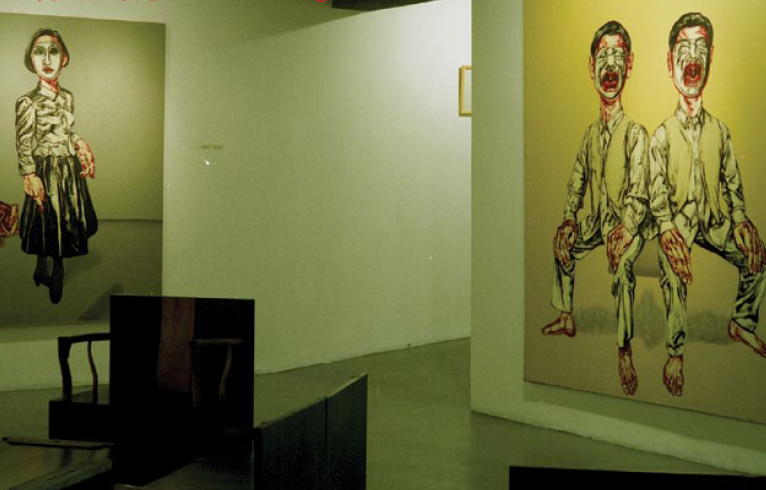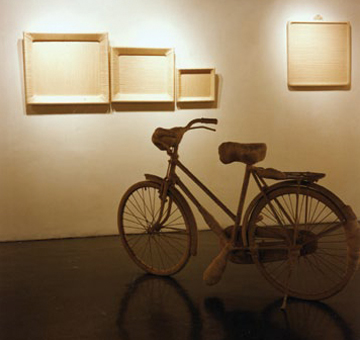WHATEVER HAPPENED TO THE COURTYARD GALLERY?
| June 29, 2011 | Post In LEAP 9

IN THE QUICK red firmament of Chinese contemporary art history, names are fascinatingly ephemeral. The specter of the here-today-gone-tomorrow plagues even the most powerful-seeming artists, collectors, and galleries. And though the overall story of art in China has been one of unbridled growth, instances of decline and fall litter the shining path. And none more so than the gallery which sang for a full decade as one of the key voices in the early choir of Chinese contemporary art, only to fall silent as the real symphony began: CourtYard.
In 1996, a select few individuals seduced by the sweet sirens of opportunity set out to give contemporary art a “public face” in Beijing. A group of investors, mostly culled from the ranks of high-profile lawyers in the capital and spearheaded by attorney-turned-impresario Handel Lee, set out to create an elegant space for high-end consumption beside the moat at the East Gate the Forbidden City. With a “cigar divan” up top and a haute restaurant on its ground floor, the 150-year-old palace building embodied the new China chic.
The gallery occupied the basement level, the second part in a comprehensive business plan. Initially directed by curator Karen Smith, it sought to bring avant-garde Chinese art to a local and international public not yet convinced that such existed. In Beijing, the only spaces really specializing in contemporary art at the time were the gallery of the Central Academy of Fine Arts (then still located in the downtown shopping area of Wangfujing), the Art Museum of Beijing Capital Normal University, and Brian Wallace’s Red Gate Gallery, founded five years prior and still going strong. From the beginning, what helped the CourtYard make such a distinct mark were its long-term strategy and a set of clearcut commercial goals. According to Smith, “We hoped that given the CourtYard’s location, and its dual function as a ‘fine dining’ restaurant, that we would be able to promote the art in a more ‘normal’ fashion, by which I mean to the kind of audiences one anticipates for art in any nation’s capital: the wealthy elite.”
For the greater part of its existence, the CourtYard existed in a pre-bubble Beijing where the only collectors were foreigners, and gallerists could show experimental work with peace of mind, even work made by non-Chinese. The gallery’s first show was a synthesis of this long-forgotten open-mindedness and was based thematically on collecting. The works on display were scrambled together from friends, like-minded visionaries, and even embassies— it wasn’t what one might have expected, neither then nor now.
On loan from the legendary Madame Song Huai-Kuei were the rebar-encased stones of Sui Jianguo, as well as a sculpture from Maryn Varbanov (her late husband, Bulgarian-born master of tapestry and mentor to many Chinese artists, see LEAP 5). There were Kenneth Noland and Morris Louis works on loan from the U.S. Embassy, and even a Rauschenberg. Private collectors contributed the works of Fang Lijun, Zhan Wang, Cai Jin, Xu Bing, Geng Jianyi, and Liu Wei, names that echo today from within the halls of the past. Finally renowned collector Uli Sigg, then serving as Swiss ambassador to China, displayed work from his private collection, and his French counterpart, a major Liu Ye piece. Local private collectors also contributed, as in the case of a Wang Jianwei piece also on hand. As an initial offering, it resonates remarkably with today’s auction catalogues and retrospectives. But then again, was this small feat no more than a mere natural step up Chinese contemporary art’s evolutionary ladder? The “apartment art” phenomenon of the 1980s eventually had to bow down to the laws of economic development, and who better to raise this curtain than a group of passionate and experienced individuals?
Among those who built the reputation of the CourtYard, an astonishing number have continued to do so in even more illustrious positions today. Lee went on to help establish Three on the Bund in Shanghai and later the Legation Quarter back in Beijing. Smith has carved out an envious career as curator, author and art historian; her then assistant Pi Li founded one of the city’s more formidable galleries, Boers-Li. Smith’s successor as director, Meg Maggio, seceded also to create the estimable Pékin Fine Arts; art dealers Jeremy Wingfield and Chin-Chin Yap, who served separate tenures there in the early 2000s only to be united as colleagues at Phillips de Pury later in the decade, are now working together on a new venture. Former manager Ingrid Dudek became Christie’s first New York specialist in Asian Contemporary; Marion Bertagna had been Assistant Vice President of Chinese Contemporary at Sotheby’s but is now the French Cultural Attaché in Shanghai; and so on. For the rest of the world, Chinese contemporary art may very well have remained more or less “underground” were it not for the people who spent long days in the CourtYard’s tiny basement exhibition space years ago.

Of course, during the gallery’s “glory days” (on one fabled night in 2003, Mick Jagger and Bill Clinton both dined in the restaurant upstairs, and presumably had a look at the art below) none of the artists knew what the future would hold. Although they did things the old-fashioned way— promotion was minimal, limited to “personal beepers and word of mouth,” and nobody was above any kind of work, not even installation— or perhaps in part due to that mentality, top artist after top artist would emerge from the CourtYard. Qiu Zhijie and Liu Xiaodong would show there, as would the famed rocks of Zhan Wang and the bicycles of Lin Tianmiao. Early on, they organized Zeng Fanzhi’s first solo show (in conjunction with Weng Ling at CAFA Gallery), and later, seminal exhibitions from Cao Fei, Yue Minjun, Zhang Dali, even the Gao Brothers and Luo Brothers.
In 2005 the gallery sat at the top of the Beijing heap, headlining that year’s edition of the CIGE art fair with a stylish party in its newly opened annex, a warehouse in the then-untrodden precinct of Caochangdi. No one would have expected that within a year, a rapid series of leadership changes would have rendered the gallery dazed and confused— and during precisely the period that the market began to sizzle. It made one last gasp with a 2006 show— realized in collaboration with MoMA— of OMA/Ole Scheeren’s designs and models for the CCTV tower, a building whose foundation was then being dug. After a strange interlude spent in a former furniture store in Caochangdi in 2007 and 2008, the gallery has returned to its downtown roots, but exhibitions are sporadic and an entire world has arisen in which it plays little part.
Skeptics may level critiques of the CourtYard, suggesting that it had the advantage of an empty playing field, but then again, the most pivotal factor was the way in which they earned the artists’ trust; Chinese art was already getting major museum shows in Europe, but galleries were scarce here when buying directly from studios, often in bulk, was the norm. It seems shocking to recall that only a decade ago, the city’s gallery listings could have fit on a single page. And so, as gallery after gallery eventually popped up in the capital, one can’t help but wonder who paved the way.


